Seeing as they were National, is it District of Columbia? Or should I say the Domain of Ceres, for Her Mysteries inform the serial on many levels, seen and unseen. It couldn't stand for Darwyn Cooke, because he wasn't even born until 1962. But then again, he is mysteriously a genie according to Wikipedia, so who knows, it could all be a Djinn Conjuration. Or is it the Doctors' Cryptolect? This seems the place preferred for these esteemed educators to present their invisible lectures. DC's in-comic news letter for many years was titled "Direct Currents" which implies the hidden symbol language is directly transmitting an energy to the reader through the printed page, an act not unlike the origin of Grant Morrison's Flex Mentallo who learned the the secrets of Muscle Mystery from a book from an advert near identical to the famous comic book ads of Charles Atlas. But if we bring in Atlas then we surely must be speaking of a Divine Column, right? Or is it Dream Control after all as an umbrella for all of these things? I think Neil Gaiman may offer a distinct clue.
It was DC Comics, back when they were National, that brought us the very first comic book super Doctor. This is a certainty because, as is fully appropriate, an illuminated Doctor was the very first of all comic book super heroes. No, Superman is not a Doctor. He's the Son of a Doctor. Superman is not the true first comic book super hero, he's the "kid brother" of Jerry Siegel and Joe Shuster's first-born four-color hero, Doctor Occult. I spoke at length about Doctor Occult in The Great Marvel Mysteries Part I, so there's no need to repeat the details here. But I think we can all take great interest in the fact that not only was the first comic book super hero a Doctor, he was Doctor Occult, a word defined at its most basic as hidden, veiled, occluded. Christopher Knowles author of "Our Gods Wear Spandex" points out that the planet Krypton's name is derived from the Greek word kryptos, which translates into Latin as "occult". And speaking of Marvel Mysteries, Knowles also points out that key jet propulsion and space program figure Jack Parsons, a Devotee of Crowley was really named Marvel Whiteside Parsons. As you probably can imagine I found this a delightful coincidence.
Five years after Doctor Occult made his debut National introduced a more famous magical Doctor, a figure to whom Doctor Strange owes a great deal for his inspiration. Doctor Fate was introduced in "More Fun" #55, May 1940 and was created by the prolific Gardner Fox and illustrator Howard Sherman.
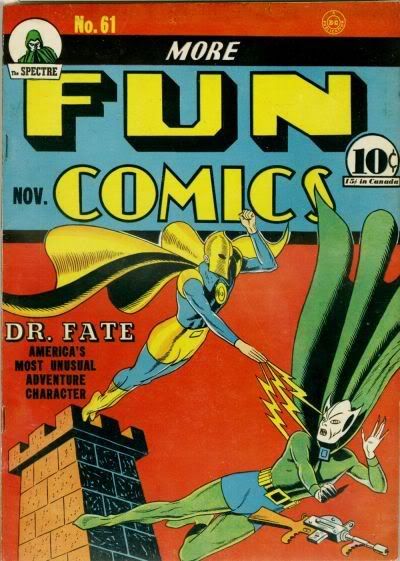
Art by Howard Sherman
For the entire first year of his appearances in "More Fun" Doctor Fate just was. A powerful magician super hero with no secret identity or origin. In "More Fun" #67, May 1941, readers learned that Doctor Fate was really Kent Nelson, the son of archaeologist Sven Nelson. It is very common to see Doctor Fate presented as a character with ties to ancient Egypt (I was under this impression until now myself), but in his original presentation it was ancient Mesopotamia that initiated Kent Nelson. As a boy Kent joined his father on an expedition to the Valley of Ur and the two discovered the Tomb of Nabu. A trap releasing poison gas killed Sven Nelson as he opened the tomb. The revived spirit of the ancient wizard Nabu took pity on the orphaned Kent and raised the boy, in the process teaching him the secrets of great magic. After twenty years Nabu gifted Kent with a magical helm and amulet and sent him to America to fight crimes both natural and supernatural as Doctor Fate.
Nabu is a Babylonian god of writing and wisdom. He is the grandson of Ea and the son of the Jovian Marduk and His consort Sarpanitum who is also Ishtar. Nabu acts as the minister and scribe of Marduk making him the patron of scribes. He is said to engrave the destiny of all men and women determining individual Fates. His name may mean something like "He who has called". Nabu appears in the Bible under the name Nebo. He shares many apparent correspondences to the Egyptian Thoth and so it should come as no surprise that he is astronomically linked to Mercury and like Thoth an analog of Hermes. Naboo is also an important planet in the Star Wars mythos as the home world of Padmé Amidala and Emperor Palpatine.
Naturally Doctor Fate takes up residence in Salem, Massachusetts, where he operates from an invisible tower without doors or windows. Doctor Fate was one of the original members of the very first comic book super hero team, the Justice Society of America which made its debut in "All-Star Comics" #3, in the winter of 1940. In his very first adventure in "More Fun" #55 Doctor Fate met his love interest and future wife Inza, a character even more key to Fate's adventures then Lois Lane is to Superman. As a direct initiate of Hermes it is very interesting to note that Doctor Fate's first opponent in was the wizard Wotan, a variant name for Odin.
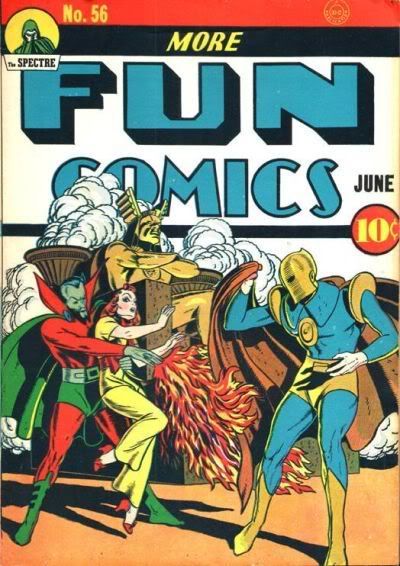
Art by Howard Sherman
Another early Doctor Fate villain was a mad scientist/art thief called Mister Who. In 1944 Doctor Fate's appearances in "More Fun" as well as those as a member of the Justice Society suddenly ceased. The character was revived in the Silver Age as one of the Justice Society members from a parallel Earth (Earth-Two which despite containing the characters from DC/National's original publications is considered a secondary world because the multiverse spawning planet Oa was unique and existed in the universe of the Silver Age DC characters). Around that time Doctor Fate's origin was further developed and the Helmet of Nabu was described as housing the essence of the ancient wizard. Whenever Kent put on the helmet he became merely the vehicle for the powerful Nabu. Nabu was further developed as a so-called Lord of Order, changing him from wizard to avatar of a dualistic struggle between the primary forces of Order and Chaos underlying DC's magical titles.
As the more modern adventures of Doctor Fate progressed DC engaged in one of their favorite activities with their characters who receive power from the use of an object. They replaced Kent Nelson with new Doctor Fates. Interestingly one of the first alterations involves Kent and Inza Nelson fusing into the singular Doctor Fate, making the character a hermaphroditic gestalt decades before Neil Gaiman made a similar alteration to the character of Doctor Occult.
Besides the Helmet Doctor Fate's other great artifact is the Amulet of Anubis, an item remarkably similar to Doctor Strange's Eye of Agamotto. Both amulets emit beams of light and reveal the truth of all things. The amulet also serves as the portal to a pocket dimension where former Doctor Fates reside, meaning it is much bigger on the inside then it appears on the outside.
Doctor Fate is yet another Hermes/Mercury/Thoth/Tehuti/Anubis/Odin/Nabu. An interesting example of the concept I frequently discuss and first made mention of in Mercury Retrograde is exemplified in "The New Adventures of Superboy" #25 from January 1982.
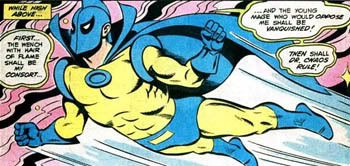
Art of Kurt Schaffenburger
This is Doctor Chaos. As this is a story set on Earth-1 there is no Doctor Fate. Instead of Sven Nelson and son it is Professor Lewis Lang and his assistant Burt Belker who discovered a tomb in the Valley of Ur and unearthed a mystic helmet. But this is Doctor Fate Retrograde. The helmet contained the essence of a Lord of Chaos. It took possession of Burt and utilized him as a vehicle for a campaign of destruction. Note the opposite color scheme utilized for Doctor Chaos, the same technique used for the Reverse Flash, Professor Zoom. In the cartoon series "Justice League Unlimited" Doctor Fate organized a covert group within the group that was a nod to Marvel's classic Defenders. Fate of course represented Strange, Aquaman/Submariner, Solomon Grundy/the Hulk, Amazo/the Silver Surfer, and Hawkgirl/Nighthawk (which should have been Batman). In 1996 in the Marvel/DC cross-publication Amalgam Comics Doctor Fate, Doctor Strange and curiously Professor X, were all combined into the singular entity Doctor Strangefate.

Art by Jose Luis Garcia-Lopez
The other Doctor of the original Justice Society of America was the less famous Doctor Mid-Nite, created by writer Charles Reizenstein and illustrator Stanley Joseph Aschmeier and first appearing in "All-American Comics" #25, April 1941.
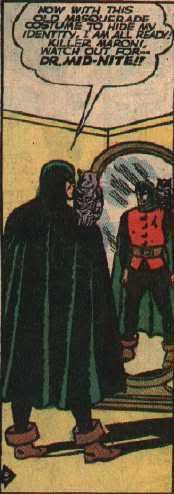
Art by Stanley Joseph Aschmier
Dotor Mid-Nite is the first blind comic book crime fighter, preceding Marvel's Daredevil by 23 years. Doctor Charles McNider was a surgeon who while operating on a witness testifying against the mob was blinded by a grenade used to kill the informant. His medical career over, McNider turned to writing as a vocation. One night an owl flew through the window of his home. Startled, he instinctively pulled off the bandages covering his eyes and discovered that he could see, but only in pitch darkness. McNider developed a special infrared visor to help him see in normal light, as well as "black-out bombs", chemical grenades that generated areas of smoky darkness. He used these devices to fight organized crime as Doctor Mid-Nite.
It is significant that his initiation to the awareness of his night vision came as a result of a visit from an owl, a commonly known emblem of the wisdom goddess Pallas Athena. Doctor Mid-Nite adopted and trained the owl, "Hooty" as a side-kick. His personal assistant was his nurse, Myra Mason.
In 1985 DC introduced Doctor Beth Chapel in the pages of "Infinity, Inc." a team book featuring the children and protégées of the Justice Society. Blinded by an explosion, Chapel also found she could still see in darkness and became a new Doctor Midnight (with the spelling of the name modified). Her relatively short career ended when she was killed in battle by the lunar Eclipso.
In 1999 the mantle was picked up again, this time by Doctor Pieter Anton Cross. Much more faithful to the design of the original Doctor Mid-Nite, this blind crimefighter has an owl named "Charlie", after the civilian name of the original Mid-Nite. In Alex Ross' monumental, apocalyptic religious allegory "Kingdom Come" Doctor Mid-Nite is depicted as Midnight, the spirit of Charles McNider manifested as living black smoke like the effect of his black-out bombs. This entity of living darkness is interestingly contrasted by "Kingdom Come's" depiction of Fate, the helmet, amulet and cape of Doctor Fate hovering over living light, with no more need for a human vehicle.
While on the surface it may seem that Doctor Mid-Nite is literally the opposite of an Illuminator, it is worth noting that this is a character whose sole special ability is to see in the darkness. His vision penetrates that which is occluded, an allegory not unlike the truth revealing function of the amulets of Fate and Strange.
The original Doctor Mid-Nite's opponents were primarily non-costumed criminals and gangsters. However, he did have a few run-ins with his opposite number, a mad scientist called Doctor Light, including a plot wherein Doctor Light created an underground (literally) secret society for criminals with an ancient Roman motif.
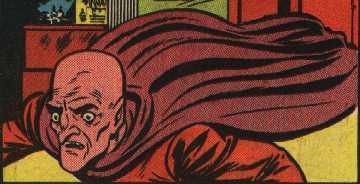
Doctor Light by Stanley Joseph Aschmier
In "The Justice League of America" #12 from June 1962 writer Gardner Fox and artist Mike Sekowsky introduced a Silver Age Doctor Light, the mad scientist Doctor Arthur Light.
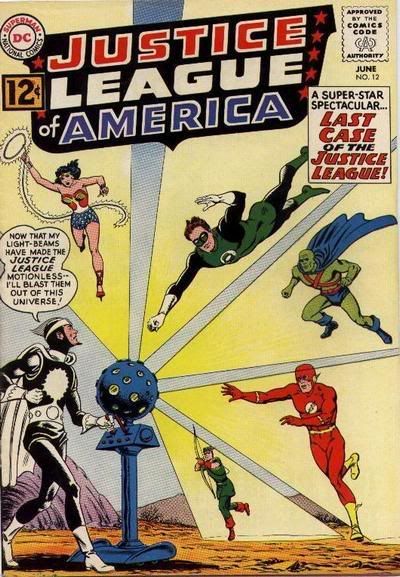
Art by Murphy Anderson
Doctor Light not only fought the JLA but also a team composed of their side-kicks, the Teen Titans. In the early eighties Light organized a team of villains called the Fearsome Five to take on the "New" Teen Titans. After several defeats the rest of the Fearsome Five expelled Doctor Light from the team.
In the justifiably controversial 2004 DC mini-series "Identity Crisis" Doctor Light was depicted at a point in the past raping Sue Dibny, the wife of Elongated Man. As an act of vengeance the League decided to mind-wipe Light using the magical powers of Zatanna. While this is a very common activity for super heroes, erasing people's memories, it is in this instance a magical lobotomy. This is very grim stuff and indeed it could be said that with this series the light at DC was significantly dimmed.
During the 1985 "Crisis on Infinite Earths" a female super hero Doctor Light was created. Unrelated to Arthur Light, she nevertheless wears an near identical costume. Both characters operate using the same name, the same powers and the same costume concurrently, a highly unusual scenario for comic books.
Another villainous Doctor faced by the Justice League of America in their early days is the highly interesting Doctor Destiny, who first appeared in "Justice League of America" #5, June 1961, and was also created by Gardner Fox and Mike Sekowsky.
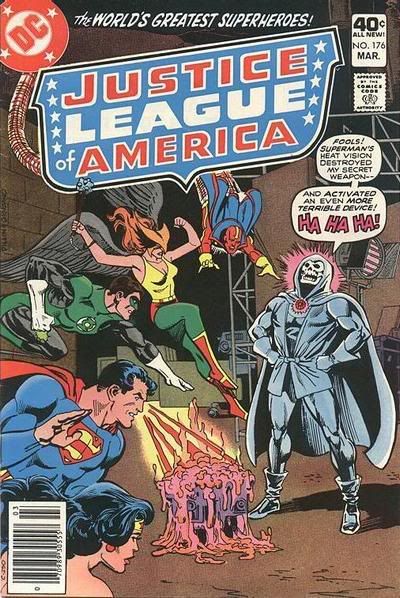
Art by Dick Dillon. Wikipedia suggests Doctor Destiny's costume design served as inspiration for the "Masters of the Universe" character Skeletor.
Doctor Destiny's real name, I kid you not, is John Dee. A mad scientist, John Dee created an anti-gravity device that he utilized to impersonate Green Lantern in order to infiltrate the Justice League, showing a great deal of ambition for a first time super criminal. Later Doctor Destiny was armed with an even greater invention, the Materioptikon, which was able to turn dreams into physical reality. After many years of nightmarish battles with the Doctor the League decided he was too great a threat and hypnotized him so that he was no longer able to dream. This caused him to fully lose his mind and his body shriveled to a near skeletal state. He was then sent to Arkham Asylum for safe keeping.
In the early issues of Neil Gaiman's "Sandman" series it was revealed that Doctor Destiny's Materioptikon was powered by a Dreamstone belonging to Morpheus, the living embodiment of Dreaming. It turns out that John Dee's mother Ethel was once the mistress of Roderick Burgess, a Crowley-like magician and member of a secret society called "The Order of the Ancient Mysteries". Burgess was also known as the Daemon King. Burgess at one point was able to capture Morpheus and kept the Lord of Dreams prisoner for many years. Burgess gave the ruby-like Dreamstone to Ethel and she later passed it to her son.
After Ethel's death, Destiny escaped from Arkham, reclaimed the Dreamstone and went on killing spree. Morpheus, recently released from imprisonment, tried but failed to stop Doctor Destiny.

Art by Sam Keith
But when Destiny tried to absorb Morpheus' power into the Stone it became overloaded and was destroyed. All the power of the Dreamstone returned to Morpheus. He returned Doctor Destiny to Arkham and mercifully restored the villain's ability to dream. Note in the above page how Gaiman plays with the name Dee. Dee, See?
In the next part of this series I'll cover even more illuminated Doctors from Marvel and DC Comics.
No comments:
Post a Comment